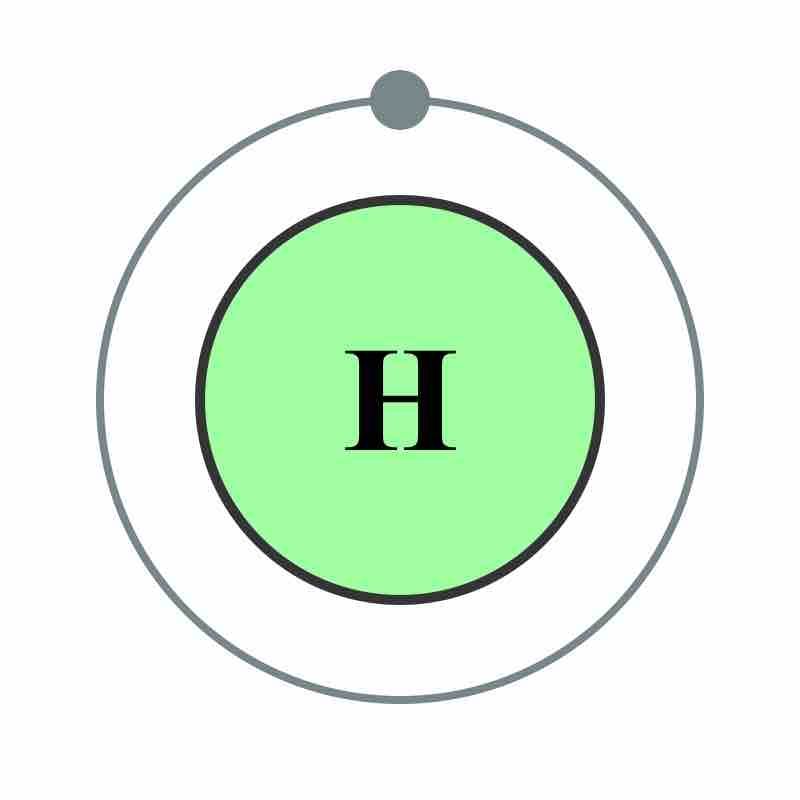Physical Properties of Hydrogen
Hydrogen is the smallest chemical element because it consists of only one proton in its nucleus. Its symbol is H, and its atomic number is 1. It has an average atomic weight of 1.0079 amu, making it the lightest element. Hydrogen is the most abundant chemical substance in the universe, especially in stars and gas giant planets. However, monoatomic hydrogen is rare on Earth is rare due to its propensity to form covalent bonds with most elements. At standard temperature and pressure, hydrogen is a nontoxic, nonmetallic, odorless, tasteless, colorless, and highly combustible diatomic gas with the molecular formula H2. Hydrogen is also prevalent on Earth in the form of chemical compounds such as hydrocarbons and water.
Hydrogen has one one proton and one electron; the most common isotope, protium (1H), has no neutrons. Hydrogen has a melting point of -259.14 °C and a boiling point of -252.87 °C. Hydrogen has a density of 0.08988 g/L, making it less dense than air. It has two distinct oxidation states, (+1, -1), which make it able to act as both an oxidizing and a reducing agent. Its covalent radius is 31.5 pm.
Hydrogen exists in two different spin isomers of hydrogen diatomic molecules that differ by the relative spin of their nuclei. The orthohydrogen form has parallel spins; the parahydrogen form has antiparallel spins. At standard temperature and pressure, hydrogen gas consists of 75 percent orthohydrogen and 25 percent parahydrogen. Hydrogen is available in different forms, such as compressed gaseous hydrogen, liquid hydrogen, and slush hydrogen (composed of liquid and solid), as well as solid and metallic forms.

The Hydrogen Atom
Many of the hydrogen atom's chemical properties arise from its small size, such as its propensity to form covalent bonds, flammability, and spontaneous reaction with oxidizing elements.
Chemical Properties of Hydrogen
Hydrogen gas (H2) is highly flammable and will burn in air at a very wide range of concentrations between 4 percent and 75 percent by volume. The enthalpy of combustion for hydrogen is -286 kJ/mol, and is described by the equation:
Hydrogen gas can also explode in a mixture of chlorine (from 5 to 95 percent). These mixtures can explode in response to a spark, heat, or even sunlight. The hydrogen autoignition temperature (the temperature at which spontaneous combustion will occur) is 500 °C. Pure hydrogen-oxygen flames emit ultraviolet light and are invisible to the naked eye. As such, the detection of a burning hydrogen leak is dangerous and requires a flame detector. Because hydrogen is buoyant in air, hydrogen flames ascend rapidly and cause less damage than hydrocarbon fires. H2 reacts with oxidizing elements, which in turn react spontaneously and violently with chlorine and fluorine to form the corresponding hydrogen halides.
H2 does form compounds with most elements despite its stability. When participating in reactions, hydrogen can have a partial positive charge when reacting with more electronegative elements such as the halogens or oxygen, but it can have a partial negative charge when reacting with more electropositive elements such as the alkali metals. When hydrogen bonds with fluorine, oxygen, or nitrogen, it can participate in a form of medium-strength noncovalent (intermolecular) bonding called hydrogen bonding, which is critical to the stability of many biological molecules. Compounds that have hydrogen bonding with metals and metalloids are known as hydrides.
Oxidation of hydrogen removes its electron and yields the H+ ion. Often, the H+ in aqueous solutions is referred to as the hydronium ion (H3O+). This species is essential in acid-base chemistry.
Hydrogen Isotopes
Hydrogen naturally exists as three isotopes, denoted 1H, 2H, and 3H. 1H occurs at 99.98 percent abundance and has the formal name protium. 2H is known as deuterium and contains one electron, one proton, and one neutron (mass number = 2). Deuterium and its compounds are used as non-radioactive labels in chemical experiments and in solvents for 1H-NMR spectroscopy. 3H is known as tritium and contains one proton, two neutrons, and one electron (mass number = 3). It is radioactive and decays into helium-3 through beta decay with a half life of 12.32 years.